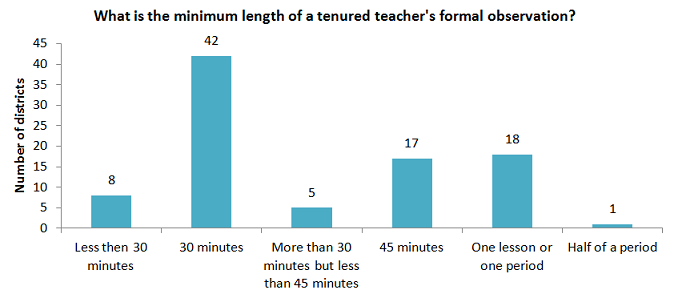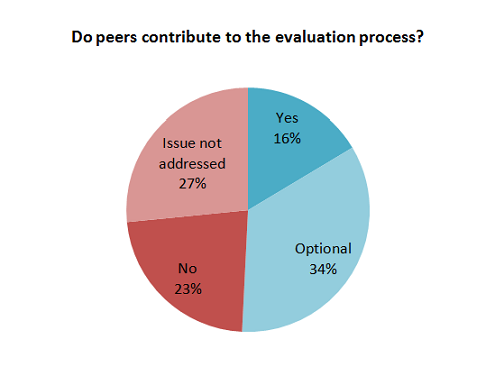District Trendline, previously known as Teacher Trendline, provides actionable research to improve district personnel policies that will strengthen the teacher workforce. Want evidence-based guidance on policies and practices that will enhance your ability to recruit, develop, and retain great teachers delivered right to your inbox each month? Subscribe here.
Special announcement: NCTQ is recruiting
new members for our Teacher
Advisory Group (TAG). The TAG supports NCTQ’s work by
providing a source of teacher voice and perspective. We are seeking current
classroom teachers who are interested in contributing to our work and learning
more about teacher policy.Click hereto learn more and apply. Applications are due
April 19.
The role of student growth
in teacher evaluations has been in the spotlight lately. While student
growth has been the hot topic and some states are considering changes to the
student growth component of their evaluation systems (read NCTQ’s take on the
impact of the Every Student Succeeds Act on this here),
observations are another essential component of teacher evaluations that
receive far less attention, yet affect more teachers. This edition of Trendline looks at how often teachers are observed, for how long and by whom.
Frequency of
Observations
On average, across the districts in our database, a tenured teacher
is observed a minimum of 2.5 times; a plurality of districts requires teachers
to be observed a minimum of one time during an evaluation cycle. The graph
below includes both formal and informal observation requirements.

Five districts do not require tenured teachers to be observed
at all. The evaluation system in Kansas City (MO) does not require
observations and tenured teachers in Sioux Falls (SD) may choose an
evaluation option that does not include any observations. In Kanawha County(WV), teachers with more than six years of experience are no
longer observed, while tenured teachers with less than six years of experience
are observed two times a year. Teachers in Burlington (VT) who have a
satisfactory evaluation are not observed after their second year of tenure. Clevelandalso uses evaluation ratings to determine the number of required observations
for tenured teachers: those who receive the highest evaluation rating the
previous year are not observed, while all others are observed four times.
Over half of the districts in the database (72 out of 128) vary
the number of observations required depending on a teacher’s years of
experience, evaluation rating or tenure status. For example, in Nashville,teachers with the highest rating are formally observed one time
with two informal observations while teachers with the lowest rating are formally
observed four times.

Length of
Observations
Among the 91 districts in the
database that specify the minimum length of a formal observation for tenured
teachers, the most common observation length is 30 minutes, followed by the
length of one lesson or class period. The shortest minimum length is 10 minutes
in Springfield (MA).

In the graph above,Birmingham and Mobile are counted as having 30
minute observations, but this is the requirement for elementary teachers; for
middle and secondary teachers observations are a full class period.
Among districts that do not
specify a length of time, five districts (Mesa, Jefferson County(CO), East Baton Rouge, New Orleans and Cincinnati) include a vague
requirement in contract or board policy that observations must be of sufficient
length for teachers to demonstrate their skills and justify the evaluator’s
conclusions.
Third party review
Generally, principals are in charge of observing and
evaluating teachers, but in some cases third parties are also involved. Since
we last looked at this topic, a smaller percentage of districts in the database
(two percent today compared to seven percent in 2013) require the
use of third party evaluators, but a larger percentage of districts (15 percent
currently compared to six percent in 2013) have optional third party review.

There are three districts that currently require third party
evaluators. In the District of Columbia“Master Educators” perform at least
one of a teacher’s formal observations.[1]
In Greenville County(SC) a team of three people evaluates
the teacher, one of whom is a teacher from another school, and in New Haven former teachers validate
the scores of any teacher who receives the highest or the lowest evaluation
rating.
In districts where the use of third party evaluators is
optional, frequently these policies allow the use of district-level
administrators or instructional supervisors during the evaluation process. Of
the 19 districts where the use of third party evaluators is optional, four (Cincinnati,Pinellas County(FL), Montgomery County (MD) and St. Paul) specifically allow principals
to request assistance in observations from the district and two (Duval County(FL) and Newark) note that third party
administrators may be used to observe struggling teachers. Newark‘s contract also states that if a school has a particularly
large number of either high or low ratings, third party evaluators may be used
to validate scores.
Peer review
In over half the districts in the database (51 percent),
peers are a part of the observation and evaluation process in some way, with 35
percent of districts making this involvement optional.[2]
Since we last looked
at this issue in 2015, the percent of districts in the database where peers
serve as evaluators for some or all of the district’s teachers has decreased from
23 percent to 15 percent, while the percent of districts in the database that
make peer involvement optional has increased from 28 percent to 35 percent.

There are seven districts that involve peers in the observation and evaluation process for all teachers (Denver, the District of Columbia, Hillsborough County(FL), Montgomery County, Minneapolis, Greenville County (SC) and Shelby County(TN)). In five districts (Oakland, Jefferson County (KY), St. Paul, Oklahoma Cityand Milwaukee) peer observations are required, but the feedback is either used for formative purposes or to inform the administrator without the peer giving a rating. The two charter management organizations in the database (Aspireand Green Dot) both include peer surveys as five percent of a teacher’s evaluation.
In districts that make peer involvement optional, 24 allow
this feedback to be consequential to the evaluation process while 14 allow this
feedback to be used for informational purposes.
As states and districts continue to refine and improve their
teacher evaluation systems, keep reading the Teacher Trendline to stay up to
date. You can also access all of the information the Teacher
Contract Database has to offer on evaluations by running a custom
report.
[1]
The District of Columbia is changing
its evaluation system for the 2016-2017 school year and will no longer be
using Master Educators.
[2] A
peer could be a current or retired teacher who is employed at either a school
or district level. A third party evaluator could be anyone, including a current
or former teacher, from outside of the school. Some evaluators may thus be
counted in both groups.
